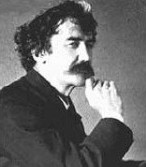You Just Call Out My Name (sa Tuiseal Gairmeach, of course, in Irish) (Pt. 1) Posted by róislín on May 31, 2013 in Irish Language
(le Róislín)
“Dia duit, a …” — hmm, what’s next, after “hello”? We could ask the same question for “Slán agat, a (ainm duine),” when saying “goodbye”! In most other languages I’ve studied, once you learn the words for “hello” and “goodbye,” putting people’s names into the phrase presents no particular challenge. That is, at least on a first-name basis, where we’re usually not concerned with honorifics and titles. However, in Irish I’d say about 75% of the personal names in use undergo a change for direct address. This form of the name is known as the “vocative” (or “calling”) case,” or in Irish, “an tuiseal gairmeach” [un TISH-ul GARzh-um-ukh, note that the last word has three syllables].
Before we go on, I’d just like to note the exceptions to the generalization above, about the other languages I’ve studied. Scottish Gaelic works a lot like Irish, as does Manx, though I wouldn’t really say I’ve studied Manx as such. I can understand it fairly well, since it’s so much like Irish and Gaelic. Welsh still shows some use of a vocative, but it’s mostly restricted now to certain widely-used words, like “fab” (son), or “fam” (mother), or “Dduw” (God). I understand that there is some use of the vocative in Cornish and that it is not present in modern Breton. So, overall, the vocative case is still fairly strong among the Celtic languages, especially on the “Goidelic” side.
As for languages that I haven’t studied (and that includes approximately 5990 of the world’s 6000 or so languages), a goodly (but not big) number also have a vocative case, but as far as I know, none of these would show the vocative by initial consonant mutation, as is done in the Celtic languages. Instead, they would add to or change the ending of the name, as in Latin, for example with “Brūtus” becoming “Brūte” for Caesar’s famous “Et tū, Brūte?” A few of the modern languages that do have a vocative case (and here’s a little Irish work-out) include Albánais, Bulgáiris, Liotuáinis, Seicis, Seirbis, and Úcráinis.
In Irish, the vocative case is always preceded by the “vocative particle,” which is simply the letter “a,” pronounced “uh” here. You’ve probably already encountered the vocative particle, in disguise, in the girl’s name “Alanna,” which comes from “a” (vocative particle) plus “leanbh” (child, pronounced “LYAN-uh” or “LYAN-uv”). You can see an páirteagal gairmeach in the captions I wrote for the two pictures above, showing James McNeill Whistler and his mother: “a Mham” and “a Shéamais.”
The most recent blog included a few examples of vocatives, shown here with some of the hello/goodbye phrases:
“a Shéamais” [uh HAY-mish], “Dia duit, a Shéamais.”
“a Sheáin” [uh HyOY-in, that “hy” is like the “h” in “human” or “Hugh,” not like “hoo,” “who,” or “whom”], “Slán leat, a Sheáin.”
“a Shinéad” [uh HIN-ayd], “Dia dhuit, a Shinéad.”
“a Shiobhán” [uh HyUV-awn, “hy” as above], “Slán agat, a Shiobhán.”
Clearly, those four examples all start with the same letter (“s”). Before we look at examples with other initial consonants, let’s look at some examples that don’t change at all for the vocative case. These are basically “píosa císte,” as might be said in English. No change = simplí! Some of the patterns for these exceptions are:
a) names beginning and ending in a vowel: a Aoife, a Úna, a Eochaidh, a Éanna, a Antaine
b) names beginning with “l,” “n,” or “r,” and ending in a vowel: a Lile, a Nóra, a Nuala, a Ruairí (NB: some speakers, mostly elderly at this point, might have a slight change in the pronunciation of the “l” or “n” , here, but it’s not indicated in writing)
c) some men’s names starting with vowels or “l,” “n,” or “r,” that are borrowed from other languages : a Liam, a Íosóg, a Uileag (Ulick or Ulysses), and,
d) a lot of Old Testament names, even ones that end in consonants that, in theory, could have a vocative ending: “a Iób” and “a Nabúcadnazar.” In fact, most of the Old Testament names that I’ve checked out don’t have case endings. Not that you’re likely to meet anyone named “Job” or “Nebuchadnezzar,” at least not sa Ghaeltacht.
Now for those eight other consonants (b, c, d, f, g, m, p, t), since we just did “s” (above). They will get the “h” written in and a change in pronunciation as well. In other words, they get lenited (i.e. softened). Examples include:
“a Bheití” [uh VET-chee], for “Beití”
“a Chearúilín” [uh HYAR-ool-inn], for “Cearúilín”
“a Dhiarmaid” [uh YEER-mwidj], for “Diarmaid”
“a Fheilimí” [uh EL-im-ee, note the “fh” is completely silent], for “Feilimí”
“a Ghearóidín” [uh YAR-ohdj-een], for “Gearóidín”
“a Mhaitiú” [uh WATCH-oo], for “Maitiú”
“a Phádraig” [uh FAW-drig OR uh FAWR-ig, depending on dialect], for “Pádraig”
“a Thaidhgín” [uh HYG-yeen], for “Taidhgín. That’s a hard one to phoneticize but remember the “g” is “hard” (as in “girl”) since it comes from the name “Tadhg.” The “y” here stands for the “y” sound of English “my”, so “Tadhg” sounds like the first syllable of “tiger” and the vowel sound “-aidh-” is the same. “Tadhg” also sounds like the name of Buster Brown’s dog, though his was spelled “Tige.” An cuimhin le duine ar bith agaibh “Tige”? Tige, his owner Buster, and Buster’s sweetheart Mary Jane were mascots for the Buster Brown line of shoes. The Brown Shoe Company is still going strong, but I haven’t heard scéala ar bith about Buster, Tige, or Mary Jane for a long time. An bhfuil siad fós ina sonóga? Nasc don fhreagra thíos.
You might have noticed that the eight examples above end either in vowels or “slender consonants” (as in Cearúilín, Gearóidín, and Taidhgín). That’s because I’m saving the names that end in “broad consonants” for the next blog. Please stay tuned for that! SGF, Róislín
PS: As for “Séamas Táilliúir,” whose song, “You’ve Got a Friend,” suggested the title for this blog, I’d love to have a chance to meet him in person, but since that dream comhrá would no doubt be i mBéarla, I doubt I’d have an opportunity to practice the tuiseal gairmeach Gaeilge on him. You never know though, James Taylor’s father’s background is largely Scottish (western North Carolina, and before that, Angus, Scotland), as outlined in Timothy White’s biography of him, Long Ago and Far Away and as name-dropped in Patrick O’Brian’s The Wine-dark Sea (in O’Brian’s Aubrey-Maturin series). Fiosrach faoi sin? Féach sa leabhar (Look inside the Book) ag http://www.amazon.co.uk/dp/B002UPVVQA/ref=rdr_kindle_ext_tmb
So, who knows? With Taylor’s family history and the influence of Irish and Scottish songs on his writing and repertoire, maybe he will take up learning Irish. B’iontach sin!
And just to recap, the vocative for “Séamas” (James) in Irish would be “a Shéamais!” [uh HAY-mish]. Remember that the first ‘s’ is now silent and the second one is pronounced as in ‘wish” or “fish.” If that pronunciation guide strikes you as remarkably similar to the Scottish forename “Hamish,” it’s no coincidence. “Hamish,” also pronounced “HAY-mish,” is based on the vocative of “Seumas”, the usual spelling of the name anns a’ Ghàidhlig (in Scottish Gaelic).
So if we were to speak Irish with any of the current crop of well-known Hamishes, “a Shéamais” would sound just right. And that would include Hamish Clark (Monarch of the Glen) and Hamish Linklater (The New Adventures of Old Christine), among others. In the fiction realm, there’s detective Hamish Macbeth in the M. C. Beaton (Marion Chesney) novels. Time-travel permitting, it would be an honor to chat with one of our Gaelic-speaking “Hamish” forebears, Hamish Scott Henderson (Seumas MacEanraig (1919-2002, poet, songwriter, festival organizer, and field guide for American folksong collector, Alan Lomax). If we want to go with middle names, we could add Holmes’ companion, Dr. John H(amish) Watson, as shown, admittedly extra-canonically in “A Scandal in Belgravia” (http://www.youtube.com/watch?feature=player_detailpage&v=snKVUcijZvQ), Hmmm, maybe I should say, “Dia daoibh, a Shéamais agus a Shéamais agus a Sheumais agus a Sheumais agus a Yamys.” Úúps, that last one is Manx!
PPS: Scéal Buster Brown? Féach anseo: http://www.brownshoe.com/history/bb-1902.asp nó http://www.straightdope.com/columns/read/2839/whatever-happened-to-buster-brown-shoes

Build vocabulary, practice pronunciation, and more with Transparent Language Online. Available anytime, anywhere, on any device.







Comments:
Tomás M:
An bhfuil caolú ag deireadh ainmneacha na bhfear a thosnaíonn le gutaí? Mar shampla- ‘Aengus — a Aenguis!’